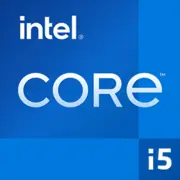Intel Core i5-11500

Intel Core i5-11500: Overview and Selection Guide for PC Build in 2025
April 2025
1. Key Specifications: Architecture, Process Technology, Performance
The Intel Core i5-11500 processor, released in 2021, belongs to the Rocket Lake-S generation. Despite utilizing a 14nm process technology (already outdated by that time), it received several enhancements:
- 6 cores and 12 threads thanks to Hyper-Threading.
- Base clock speed of 2.7 GHz, maximum turbo frequency of 4.6 GHz (for one core).
- 12 MB L3 cache and support for PCIe 4.0 (20 lanes).
- Integrated graphics with Intel UHD Graphics 750 (32 EUs, frequency up to 1.3 GHz).
- TDP of 65W, making it energy-efficient.
Performance:
According to Geekbench 6 (2025), the processor scores 2064 points in single-core and 8564 points in multi-core tests. This level is sufficient for most everyday tasks and moderate gaming. For instance, in Cyberpunk 2077 paired with a discrete graphics card like the NVIDIA RTX 3060, it achieves stable 60 FPS on high settings.
Key Features:
- Support for Resizable BAR (to speed up graphics card performance).
- Intel DL Boost and GNA 3.0 technologies (AI workload optimization).
- Integrated GPU for basic tasks.
2. Compatible Motherboards
The processor uses the LGA 1200 socket, which limits the choice to motherboards with 500 series chipsets:
- H510: Budget option (starting at $70). Suitable for office PCs, but does not support PCIe 4.0 and memory overclocking.
- B560: Optimal choice (starting at $100). Supports PCIe 4.0 for SSDs and DDR4-3200 memory.
- Z590: Premium segment (starting at $180). Suitable for enthusiasts, but CPU overclocking is not possible (the i5-11500 model does not have a “K” suffix).
Recommendations:
- For gaming builds, choose the B560 with good VRM cooling (e.g., MSI B560M-A Pro).
- Avoid cheap H510 boards if you plan to use fast NVMe drives.
3. Supported Memory Types
The processor only works with DDR4 (up to 3200 MHz in Gear 1 mode). DDR5 and LPDDR4x are not supported.
Tips:
- Optimal volume: 16 GB (2x8 GB). For gaming and video editing, you can use 32 GB.
- Choose modules with low timings (CL16-CL18) for better responsiveness.
- Example: the Crucial Ballistix DDR4-3200 CL16 kit (around $75 for 16 GB).
4. Power Supply Recommendations
With a TDP of 65W and using a discrete graphics card (e.g., NVIDIA RTX 3060), a 500-600W PSU will be sufficient.
Selection Criteria:
- 80+ Bronze certification or higher.
- Semi- or fully modular design.
- Examples:
- Corsair CX550M (550W, $65).
- EVGA 600 BQ (600W, $70).
Important: For high-end GPUs (RTX 4070 and above), a PSU of 750W or more will be required, but the i5-11500 may become a "bottleneck" in such builds.
5. Pros and Cons
Pros:
- Good price (new models in 2025 cost around $180).
- Energy efficiency (suitable for compact cases).
- Integrated graphics for a backup option.
Cons:
- Outdated 14nm process technology (competitors are using 7nm).
- No support for DDR5 and PCIe 5.0.
- Limited upgrade potential (LGA 1200 socket is obsolete).
6. Use Cases
- Gaming: Ideal for Full HD gaming paired with a graphics card like the RTX 3060 or AMD RX 6600. In CS2 or Fortnite, it achieves 120+ FPS.
- Work Tasks: Quick photo processing in Lightroom, rendering simple 3D scenes.
- Multimedia: Streaming, 4K video decoding via iGPU.
Example: An office PC based on i5-11500 + 16 GB DDR4 + 1 TB SSD will cost around $400-500.
7. Comparison with Competitors
- AMD Ryzen 5 5600X (6/12, 3.7-4.6 GHz, 7nm): Better in multi-threaded tasks (Geekbench Multi ~9200), but more expensive ($220).
- Intel Core i5-12400F (6/12, 2.5-4.4 GHz, 10nm): Higher IPC and support for DDR4/DDR5, but without iGPU ($190).
Conclusion: The i5-11500 is advantageous for those on a budget and in need of an iGPU.
8. Practical Assembly Tips
1. Cooling: The stock cooler will suffice, but for quieter operation, opt for a tower cooler (e.g., DeepCool Gammaxx 400, $25).
2. Drives: Use NVMe SSDs with PCIe 4.0 (e.g., WD Black SN770).
3. Case: Ensure good ventilation (example: Fractal Design Focus G).
4. Drivers: Install the latest version of Intel ME and graphics drivers.
9. Final Conclusion: Who Should Consider the i5-11500?
This processor is suitable for:
- A budget PC for office work, study, or moderate gaming.
- Importance of energy efficiency (e.g., for HTPC).
- Need for backup graphics in case the discrete GPU fails.
Alternatives: If the budget allows, it is better to opt for the i5-12400F or Ryzen 5 7600 for future upgrades. However, in 2025, the i5-11500 remains a valuable option for "here and now."
Basic
CPU Specifications
Memory Specifications
GPU Specifications
Benchmarks
Compared to Other CPU
Share in social media
Or Link To Us
<a href="https://cputronic.com/en/cpu/intel-core-i5-11500" target="_blank">Intel Core i5-11500</a>